Presented at SEG 2011
For a PDF of this paper click here
Summary
Heliborne VTEM and ZTEM surveys were flown over East Bull Lake Intrusive Complex near Massey ON. The VTEM results show good correlation with known occurrences and identify new areas for follow-up. The ZTEM survey results correlate well with known geology and provide indications of deep structure that agree with previous scalar and tensor AMT survey results. Comparisons between these data sets and the East Bull Lake geology and structure are showcased using 1D-2D-3D inversion modeling.
Introduction
In September 2010, Mustang Minerals Corp. (Toronto, ON) contracted Geotech to fly heliborne ZTEM survey over East Bull Lake property (Figure 1). The survey followed a previously successful VTEM survey in May-June, 2007. The East Bull Lake Intrusion (EBLI) is a 20km long gabbro-anorthosite intrusive complex located 80km west of Sudbury, Ontario. It consists of two separate zoned intrusions joined by a 5km long feeder dyke (Figure 2). The EBLI is also crosscut by two major structures: the Folson Lake (FLFZ) and Parisien Lake (PLFZ) fault zones; Figure. 2). The property is considered to have excellent potential to host a significant nickel-copper, PGM (platinum group metal) deposit but is, as yet, not developed for mining.
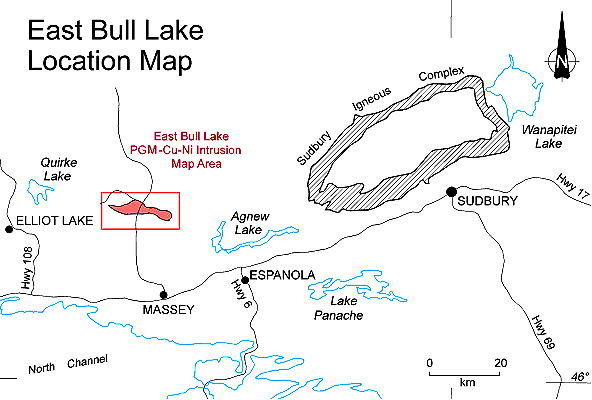
Figure 1: East Bull Lake property location (courtesy Mustang Minerals Corp.; \http:www.mustangminerals.com).
Property History
The East Bull Lake area had seen limited mineral exploration activity take place between 1950 and 1962 involving a number of mining and exploration companies that were exploring a portion of the property for gold, copper and nickel deposits. The potential for PGM deposits on the property was not considered until the late 1980’s (Brisbin et al., 2001).
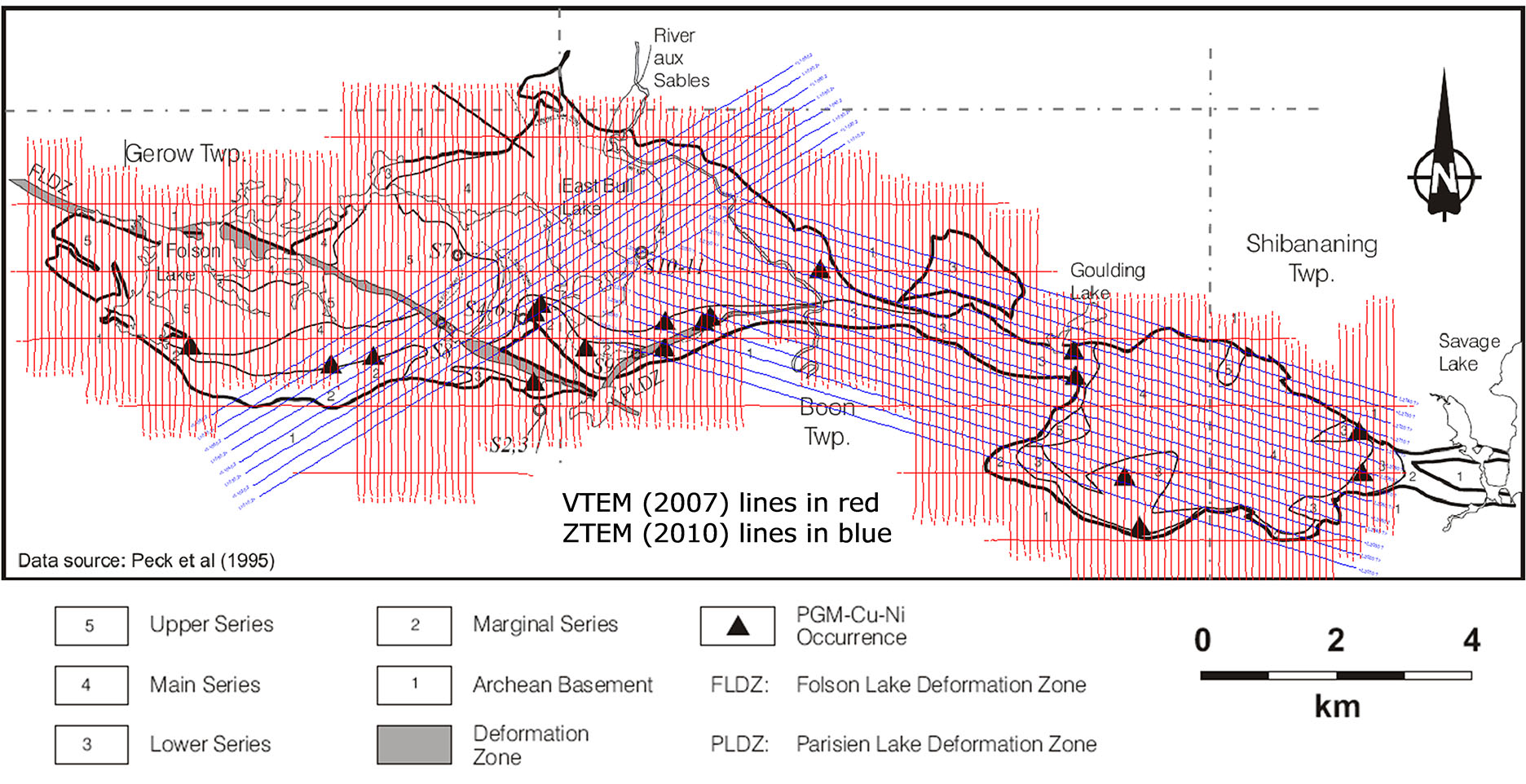
Figure 2: East Bull Lake Intrusion geology, PGM occurences and VTEM-ZTEM survey lines (modified after Brisbin et al., 2001).
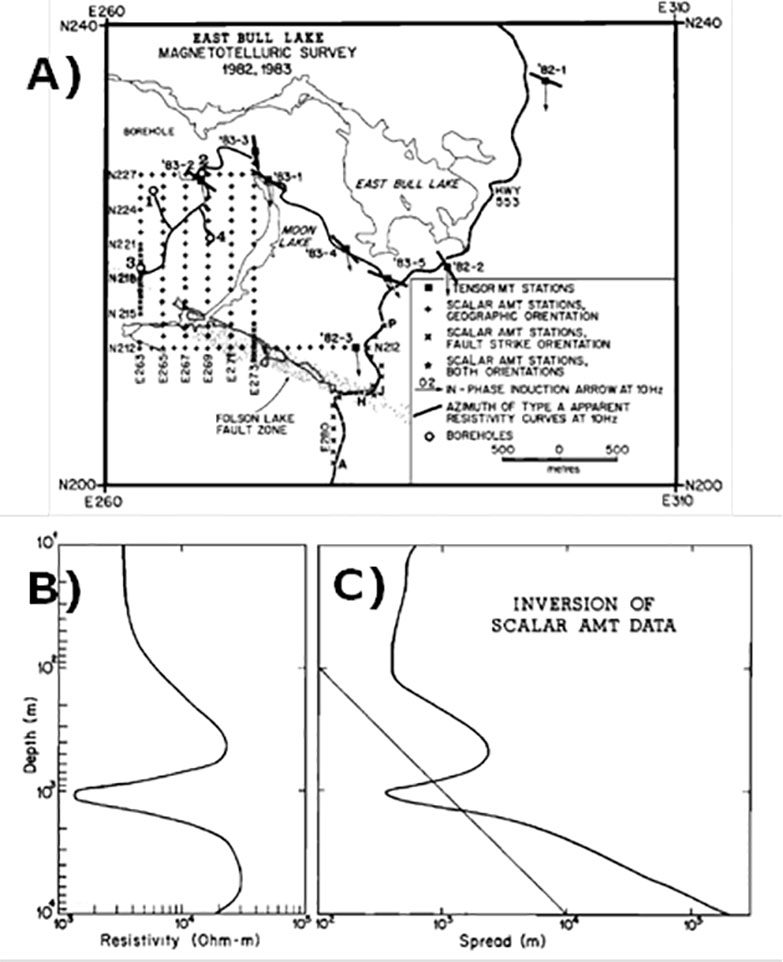
Figure 3: a) Location of scalar AMT and tensor MT sites obtained at East Bull Lake in 1982 and 1983; b-c) 1D inversion of scalar AMT data over EBLI, showing well resolved conductor at depth below 800m (after Kurtz et al., 1986).
In the early 1980’s, EBLI was also one of a small number of Precambrian crystalline intrusions selected by Atomic Energy of Canada Ltd. to test the capability of geotechnical methods for defining fault structures within bedrock and also for the purpose of evaluation for long-term storage of nuclear waste. At that time, in addition to ground VLF EM, magnetic, gravity surveys, both scalar and tensor audio magnetotelluric (AMT-MT) survey measurements were obtained on the site by the GSC (Kurtz et al., 1986; Fig. 3).
In addition to identifying the ESE-WNW trending Folson Lake fault zone (FLFZ) as a major regional conductive structure (Figure 2-3a), on the basis of the AMT-MT results, a well resolved conductor was found at a depth below 800m (Fig. 3b) and was later drill-tested by AECL to reveal a faulted, troctolitic later marking the base of the East Bull Lake intrusive, which was also PGM-mineralized (R. Dunbar, personal communication, 2010).
In 1990, the Ontario Ministry of Northern Development, Laurentian University and Ontario Geological Survey completed an extensive study of EBLI that concluded that the “potential exists for extremely large tonnages of sulphide mineralization, perhaps even massive sulphides (along the floor of the intrusion), which have platinum-group element-enrichment levels equating to reef environments” (R. Dunbar, personal communication, 2010). Geologic mapping has determined that the lower and marginal series phases of EBLI (Figure 2) host all known PGE-rich mineralization, found mainly in disseminated sulphides (<1%) but also as high as 10% massive to semi-massive chalcopyritic and pyrrhotitic sulphides (Brisbin et al., 2001).
Following the 2007 VTEM survey over East Bull Lake, prospective EM anomalies were identified in areas where mineralization was previously unknown and which were later proven to be associated with highly anomalous nickel-copper-PGM values in surface samples and drilling.
In early 2008 initial drilling of a VTEM target at Parisien Lake yielded intersections that included 1.1m of 9.3% copper and 12/5 g/t PGM from 89m down hole depth and 10m of 0.4% nickel at shallow depth. Historical drilling at East Bull Lake prior to Mustang’s involvement intersected 0.5m of 3.9 % nickel in the central part of the intrusion (R. Dunbar, personal communication, 2010). The ZTEM survey objectives were to define potential deep extensions or structures potentially associated with the VTEM mineralized conductive features.
VTEM Survey Results
The 2007 VTEM (versatile time-domain electromagnetic) system (Witherly et al., 2004, Witherly and Irvine, 2006, Prikhodko et al., 2010) survey (Orta and Bagrianski, Geotech Ltd. internal report, 2007) consisted on 867 line-km flown along 100m spaced NS lines and 1km spaced EW tie-lines, with EM and magnetic sensors at 40m and 65m avg. elevations, respectively. The VTEM and magnetic results at EBLI are presented in Figures 4-5. The late-channel (off-time) EM Time Constant (Tau) image in Figure 4a was obtained from the Z-coil, dB/dt response.
For potential conductive mineralized targets, the eddy current decays more slowly with of time, giving larger values of Tau, relative to poor conductors. Medium-to-large values of Tau, with responses extending into late times, are an indication of potential mineralization for base-metal and PGM exploration. VTEM anomalies are generally not expected over disseminated sulphides, unless secondary enrichment is present.
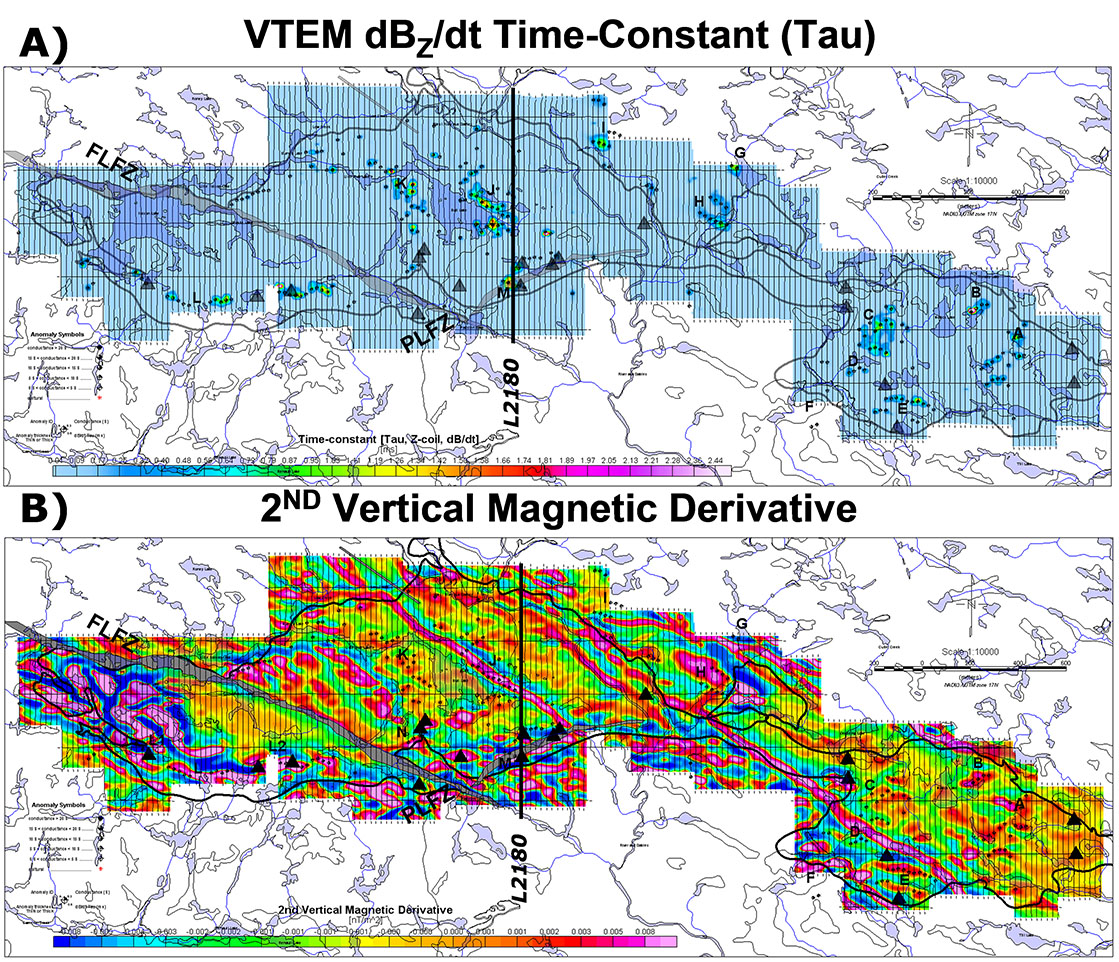
Figure 4: East Bull Lake VTEM survey results: a) dBZ/dt time-constant (Tau) and b) 2ND vertical magnetic derivative of TMI, with EM anomaly picks, anomalous zones (A-N), known mineral occurrences (triangles) and EBLI outline.
At EBLI, small-to-medium values of Tau in the range of 0.21 to 3.3 milliseconds are generated from the dBZ/dt response (Figure 4a and Figure 5b); with a similar range obtained from the BZ-field response. Anomalies (A-N – Fig. 4) occur as either small isolated groups or as short lineaments.
As shown in the calculated second vertical magnetic derivative (Figure 4b), the magnetic lineaments related to late dikes and secondary faults are observed with north-west to south-east trends. Stronger magnetic signatures along the southern margin of EBLI, where the mineral occurrences are concentrated, relate to the lower and marginal series phases that feature higher magnetite and are also PGM sulphide enriched (Brisbin et al., 2001). Most VTEM anomalies have a strong magnetic correlation, while others (C, K, I) are only weakly magnetic.
A VTEM anomaly (M) located in the lower margin suite of rocks of the EBLI was drill-tested at Parisien Lake and intersected two mineralized zones in 2008. Figure 5c presents the RDI resistivity-depth image (Meju, 1998) over L2180 from Parisien Lake (Figure 4) that shows the strongest conductive anomaly at 93 metres of depth (just 4 metres below actual); but with an exaggerated depth extent of 90 metres. The EmflowTM (Encom/Pitney Bowes Pty Ltd., North Sidney, NSW, AU) conductivity-depth image (CDI; Fig. 5d) misplaces the top of the target at a shallower depth of 69-72 metres (20 metres above); but is more realistic in terms of its depth extent of just a few metres. From both these results, we conclude that the VTEM response is accurately mapping the massive Cu-PGM sulphide occurrence intersected at 89m down hole. MaxwellTM (EMIT Technologies Pty Ltd., Midland, WA) 3D EM plate models corroborate these results.
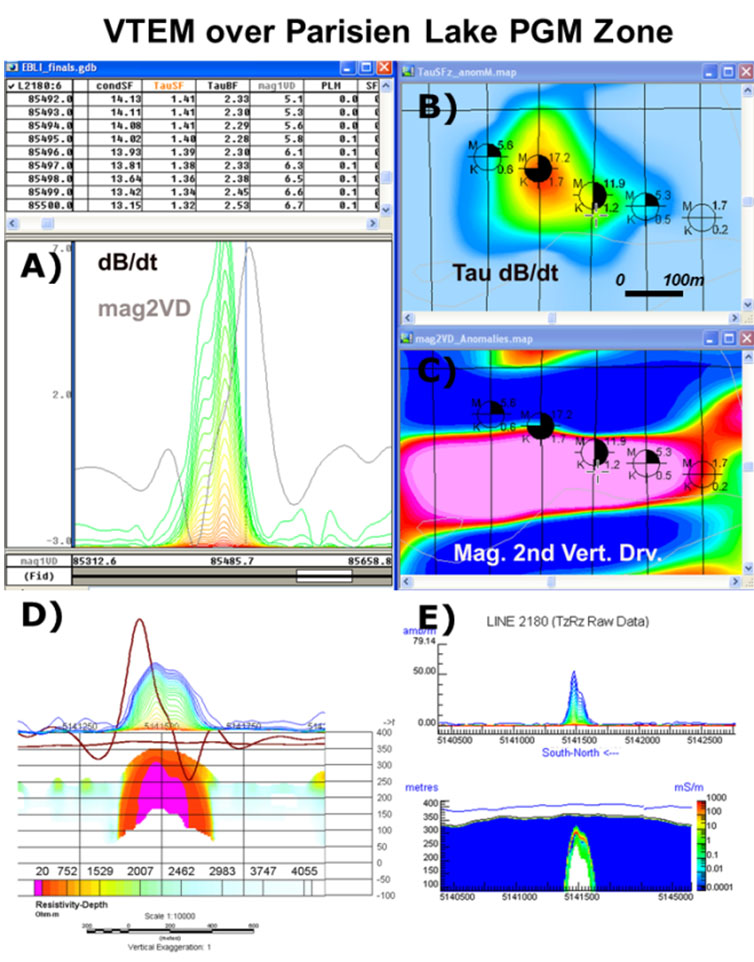
Figure 5: VTEM survey results over Parisien Lake PGM-sulphide occurrence (Anomaly M): a) dBZ/dt late-channel decay and magnetic 2VD profiles; b-c) plan views dBz/dt Tau and magnetic 2VD of TMI with picked EM anomalies; d) RDI effective resistivity and e) EMflow CDI cross-sections.
ZTEM Survey Results
ZTEM is an airborne variant of the AFMAG natural field EM technique (Ward, 1959, Labson et al., 1985) where a single vertical-dipole air-core receiver coil is flown over the survey area in a grid pattern, similar to regional airborne EM surveys. Two orthogonal, air-core horizontal axis coils are placed close to the survey site to measure the horizontal EM reference fields. Data from the three coils are used to obtain the Tzx and Tzy Tipper (Vozoff, 1972) components at five to six frequencies in the 30 to 720 Hz band.
The 2010 ZTEM (z-axis tipper electromagnetic) system (Lo and Zang, 2008, Lo et al., 2009, Legault et al., 2009ab, Pare and Legault, 2010) survey consisted on 228 line-km flown along 200m spaced over two survey blocks, East and West, that centred on each EBLI lobe (Venter et al., Geotech Ltd. internal report, 2010). East block was flown in a SE-NW (N-107O) direction and West block with NE-SW (N-059O) lines. The EM and magnetic sensors were at 85m and 100m avg. elevations, respectively. The ZTEM survey results at EBLI are presented in Figures 6-8.
Figure 6 presents the ZTEM tipper results in plan shown as Total Divergence (DT) images (Lo et al., 2009) that are analogous to the VLF Peaker parameter of Pedersen (1998). DT’s convert the tipper cross-overs into peaks for easier interpretation/visualization in plan view. Shown are the high (360Hz) and Low (30Hz) frequency DT’s of the In-Phase component, for depth-comparison purposes, with the EBLI outline overlain. Several prominent linear conductive trends are identified (ZW1-ZE2), including the Folson Lake FLFZ and the northern contact of EBLI. The similarity of 360Hz high and 30Hz low frequency results suggests that these major structures subcrop and also have considerable vertical extent in this skin depth range. However, there seems to be little correlation with ZTEM and the VTEM anomalies or the known PGM occurrences – this may relate to their limited size and depth extent. It seems that ZTEM is defining regional geologic structures.
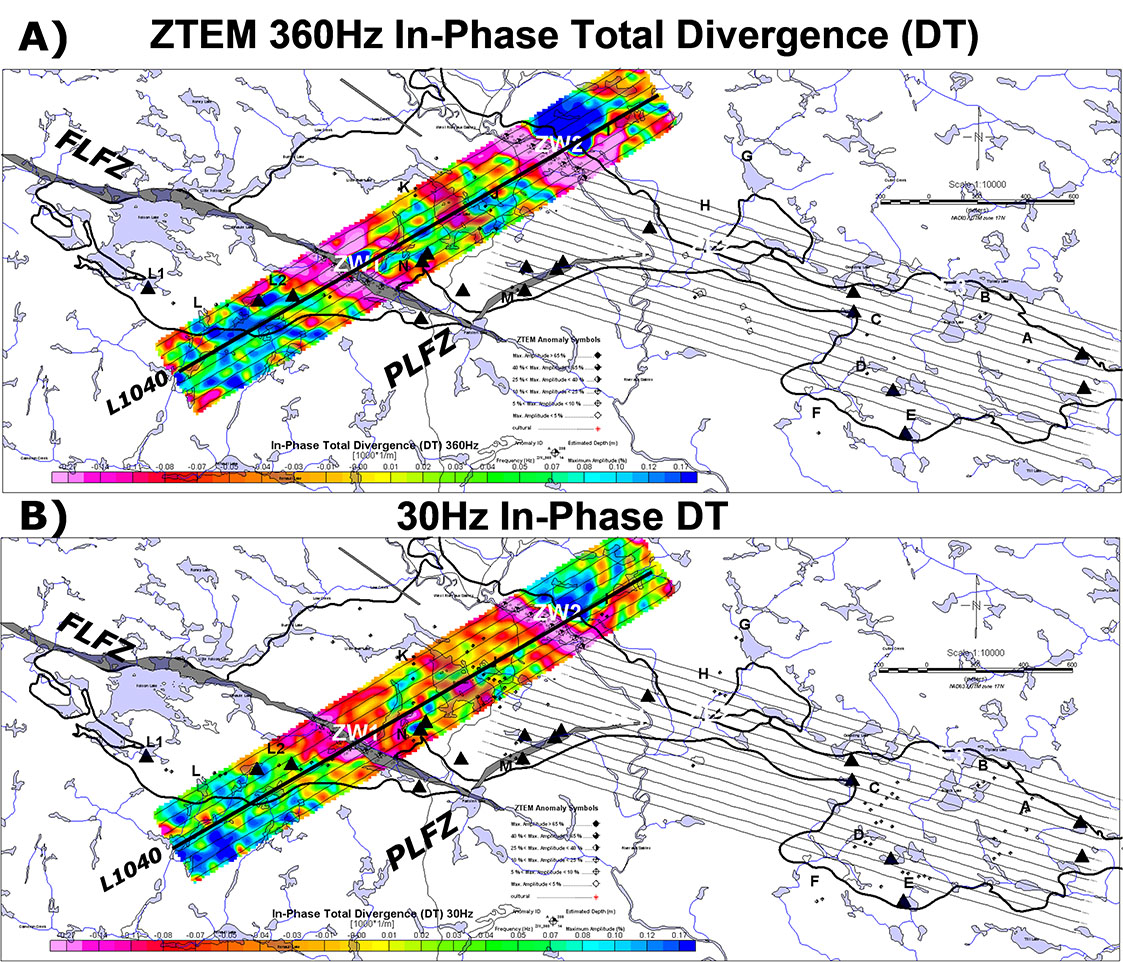
Figure 6: ZTEM Total Divergence (DT) of In-Phase Tipper at: a) 360Hz and b) 30Hz, with EM anomaly picks, anomalous zones (ZW1-ZE3), known mineral occurrences (triangles) and EBLI outline. ZTEM results from East Block are masked by request.
Figure 7 present the 2D cross-sectional resistivity results obtained from the Zvert2D inversion (Legault et al., 2009b) based on the 2D MT codes/methods of Wannamaker et al. (1987), Tarantola (1987) and de Lugao and Wannamaker (1996). Zvert2d utilizes the In-Line (Tzx) ZTEM tipper data, an apriori model (in this case, 5k Ω-m half-space) and imposes an “air layer”, below the receiver, in order to obtain a 2D resistivity distribution. L1040 directly over the EBLI intrusive indicates that it is a shallower, more resistive body surrounded by lower resistivity rocks at depth and further west, which is consistent with the location of the Folson Lake FLFZ and the northern EBLI contact, which is a known fault-fracture zone. Significantly, the ZTEM inversion defines a deep conductive layer at 0.5-1km depth which coincides with the known base of EBLI and agrees with the AMT-MT findings of Kurtz et al. (1986). Figure 8 presents the 3D Voxel of the combined 2D inversions for all West Block lines which highlights the good correlation between ZTEM and the known geology.
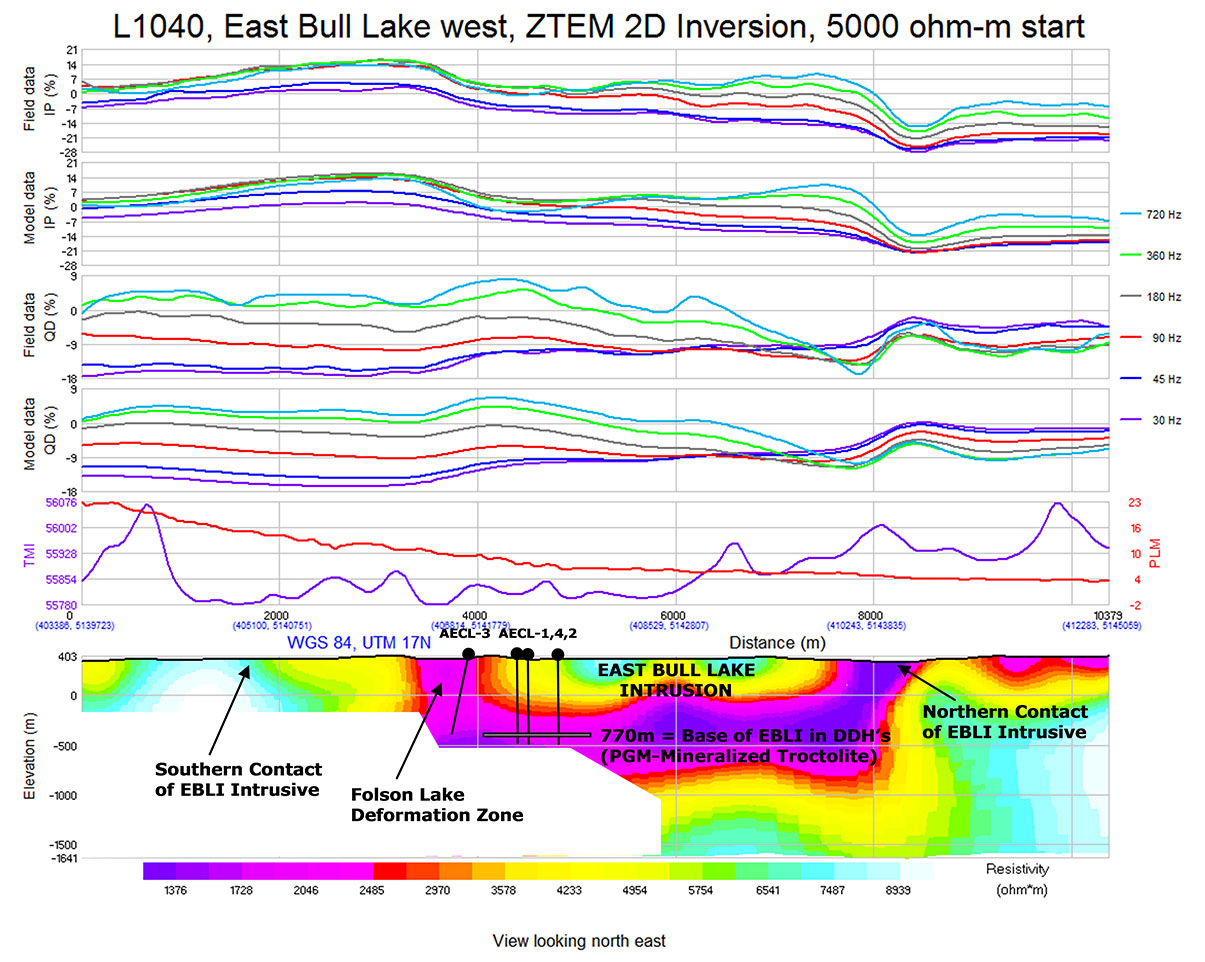
Figure 7: ZTEM 2D inversion and forward/observed Tzx (In-line) tipper profiles for survey line over EBLI West, with AECL projected drillholes (Fig. 3a), showing excellent correlation with major geologic features, as well as location of 770m depth-to-basement conductive layer predicted by the AMT-MT survey results (Fig. 3b). Results in lower left hand corner are masked by request.
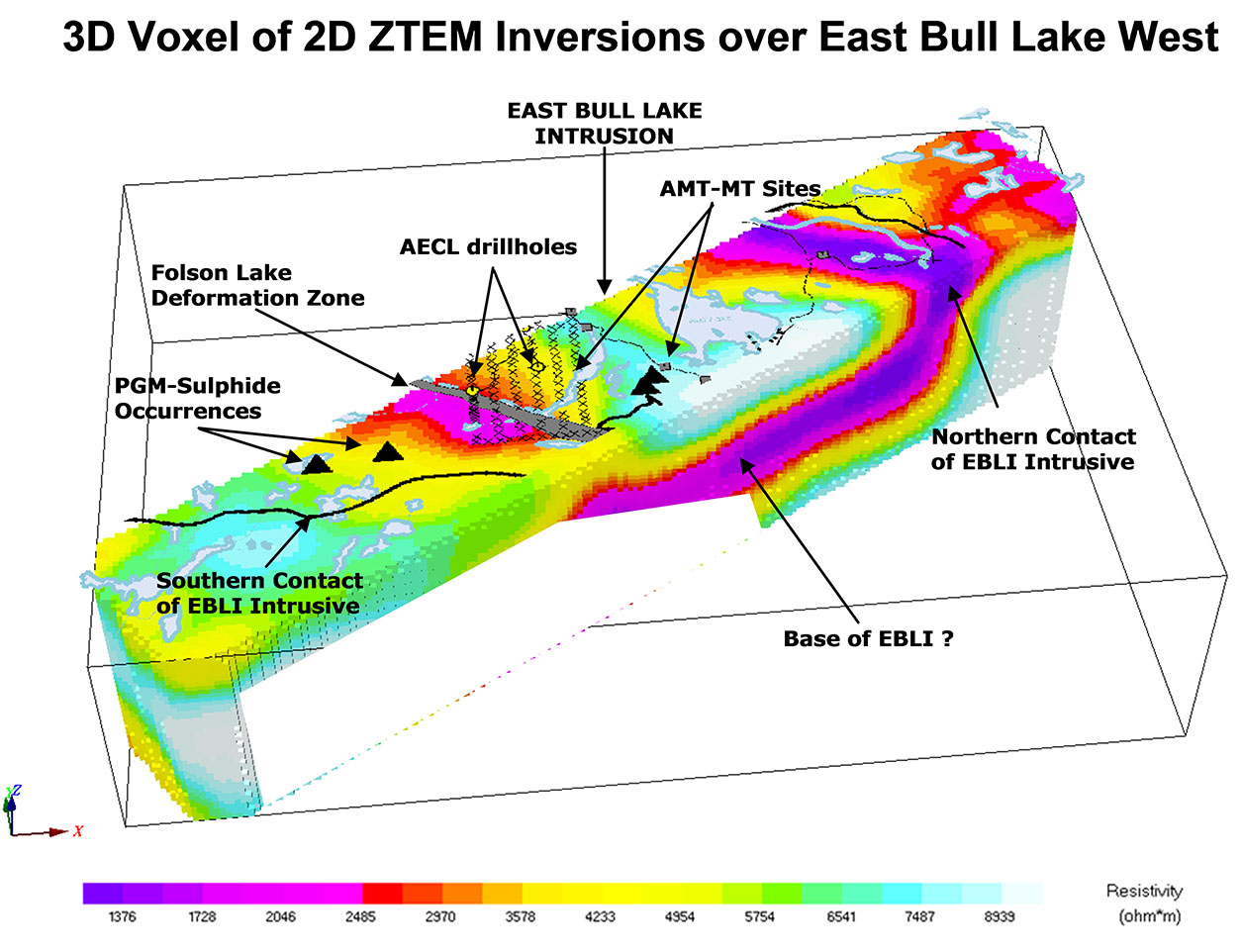
Figure 8: 3D Voxel view of ZTEM 2D inversion over East Bull Lake West block, with location of AECL drillholes & AECL-GSC AMT-MT sites, PGM occurrences and EBLI outline. Results in lower left hand corner have been masked by request.
Conclusions
Helicopter-borne VTEM survey results over the East Bull Lake Intrusive Complex have identified weak to moderate conductance anomalies associated with previously unmapped, highly anomalous PGM-sulphide occurrences, many of which have been successfully drill-tested. ZTEM AFMAG surveys have defined major structures surrounding the EBLI that strikingly agree with previous AMT-MT findings, as well as drilling, including the fractured PGM-mineralized base of the complex, at 800m depths.
The relative success of the VTEM and ZTEM surveys at East Bull Lake is in marked contrast to the apparently poor correlation between VTEM and ZTEM anomalies. This is logically explained by the differences in depth resolution-penetration and relative size-conductivity of the targets each system is most sensitive to. VTEM is best suited for high resolution mapping of higher-conductance massive to semi-massive sulphide targets in the 0-500m range – with depth-detectability sensitivity proportional to target size. On the other hand, ZTEM is best suited for larger scale and deeper resistivity structures, associated with regional geology and sometimes extending to great depth (1-2km), that depend only on lateral resistivity contrasts. It seems that both technologies complement each other as mapping tools of targets of different scale & style as applied to PGM-sulphide exploration.
Certainly, 3D inversion of ZTEM (Holtham and Oldenburg, 2008, 2010) VTEM data could provide valuable insight and further explanation of the relationship between the mineralized zones and controlling structures at East Bull Lake.
Acknowledgements
The authors wish to thank Mustang Minerals Corp., joint-venture partner Western Areas NL and Geotech Ltd. for allowing us to show these results and for sponsoring the study.
References
Brisbin, D., Wood, P., Kleinboeck, J., and Lapierre, K., 2001, Geology of the East Bull Lake Intrusion and its contact-type PGE-Cu-Ni mineralization, Field Trip Guidebook, Laurentian University SEG Student Chapter 2ND Annual Workshop in Mineral Exploration, 25 pp.
De Lugao, P.P., and Wannamaker P., 1996, Calculating the two-dimensional magnetotelluric Jacobian in finite elements using reciprocity, Geophysical Journal International, 127, 806-810.
Kurtz, R.D., Ostrowski, J.A., and Niblett, 1986, A magnetotelluric survey over the East Bull Lake Gabbro-Anorthosite Complex, Journal of Geophysical Research, 91, 7403-7416.
Labson, V. F., Becker A., Morrison, H. F., and Conti, U. , 1985, Geophysical exploration with audio frequency natural magnetic fields, Geophysics, 50, 656-664.
Legault, J.M., H. Kumar, B. Milicevic, and L. Hulbert, 2009, ZTEM airborne tipper AFMAG test survey over a magmatic copper-nickel target at Axis Lake in northern Saskatchewan, SEG Expanded Abstracts, 28, 1272-1276.
Legault, J.M., H. Kumar, B. Milicevic, and P. Wannamaker, 2009, ZTEM tipper AFMAG and 2D Inversion results over an unconformity uranium target in northern Saskatchewan, SEG Expanded Abstracts, 28, 1277-1281.
Lo, B., Legault, J.M., Kuzmin, P., and Combrinck, M., 2009, Z-TEM (Airborne AFMAG) tests over unconformity uranium deposits, 20TH ASEG International Geophysical Conference & Exhibition, Adelaide, AU, Extended Abstracts, 5 pp.
Lo, B., and Zang, M., 2008. Numerical modeling of Z-TEM (airborne AFMAG) responses to guide exploration strategies, SEG Expanded Abstracts, 27, 1098-1101.
Meju, M.A., 1998, Short Note: A simple method of transient electromagnetic data analysis, Geophysics, 63, 405–410.
Orta, M., and Bagrianski, A., 2007, Report on a helicopter-borne versatile time domain electromagnetic (VTEM) geophysical survey, East Bull Lake property, for Mustang Minerals Corp., internal report by Geotech Ltd., 28 pp.
Paré, P., and Legault, J.M., 2010, Ground IP-Resistivity, airborne Spectrem and helicopter ZTEM survey results over Pebble copper-moly-gold porphyry deposit, Alaska, SEG Expanded Abstracts, 29, 1734-1738.
Pedersen, L.B., 1998, Tensor VLF measurements: Our first experiences, Exploration Geophysics, 29, 52-57.
Prikhodko, A., Morrison, E, Bagrianski, A., Kuzmin, P., Tishin, P., and Legault, J.M., 2010, Evolution of VTEM – technical solutions for effective penetration, 21ST ASEG International Geophysical Conference & Exhibition, Sidney, AU, Extended Abstracts, 5 pp.
Tarantola, A., 1987, Inverse Problem Theory, Elsevier, New York, 613 pp.
Venter, N., Legault, J.M., Zhao, S., and Kumar, H., 2010, Report on a helicopter-borne z-axis tipper electromagnetic (ZTEM) and aeromagnetic geophysical survey, East Bull Lake east and west blocks, for Mustang Minerals Corp., internal report by Geotech Ltd., 58 pp.
Vozoff, K., 1972, The magnetotelluric method in the exploration of sedimentary basins: Geophysics, 37, 98–141.
Wannamaker, P. E., Stodt, J. A., and Rijo, L., 1987, A stable finite element solution for two dimensional magnetotelluric modeling: Geophysical Journal of Royal Astronomical Society, 88, 277-296.
Ward, S. H., 1959, AFMAG – Airborne and Ground: Geophysics, 24, 761-787.
Witherly, K., and R. Irvine, 2006, The VTEM airborne electromagnetic system – benchmarking continuous improvement via repeat surveys over time, SEG Expanded Abstracts, 25, 1273-1277.
Witherly, K., Irvine, R., and Morrison, E.B., 2004, The Geotech VTEM time domain helicopter EM system: SEG Expanded Abstracts, 23, 1217-1221.